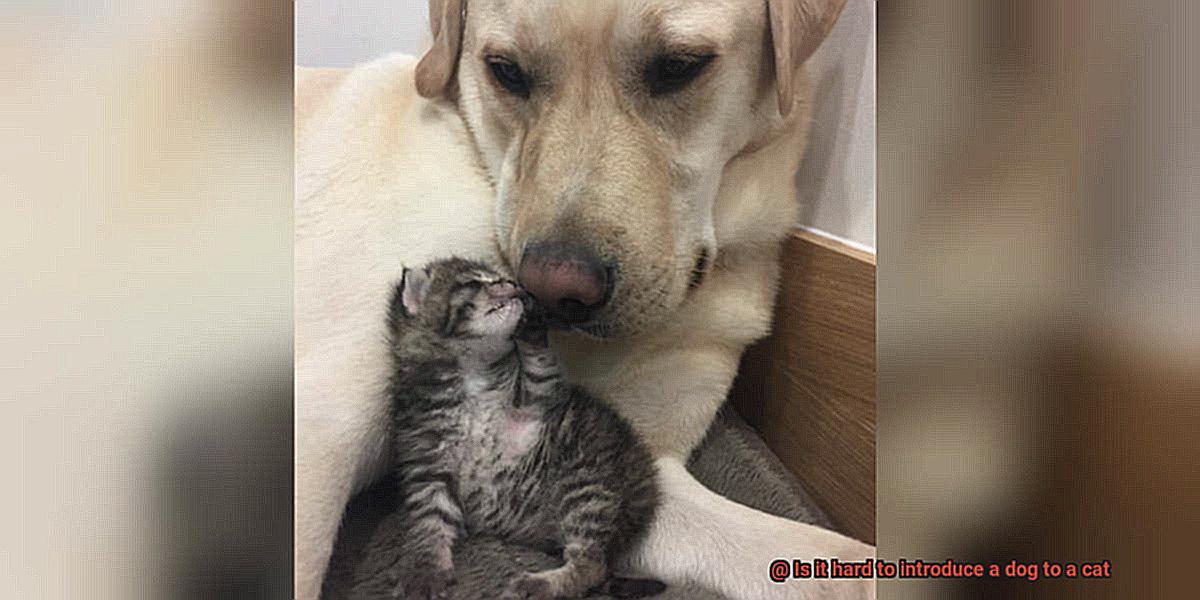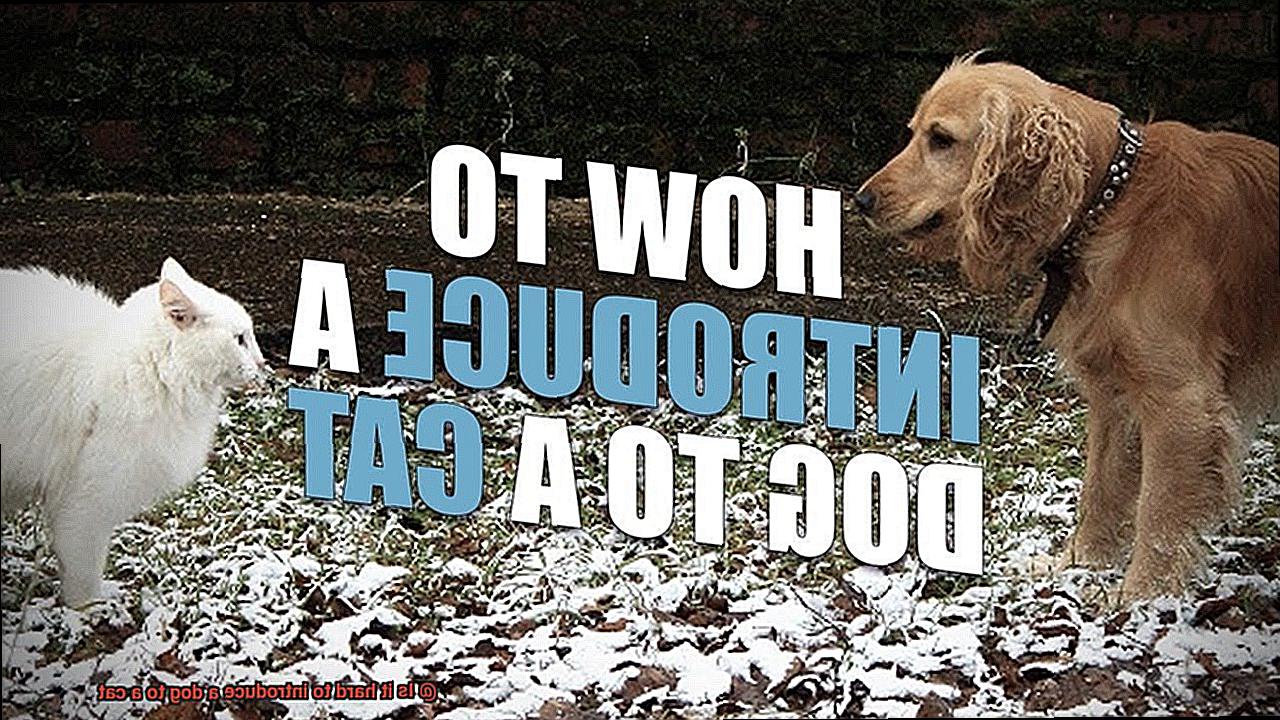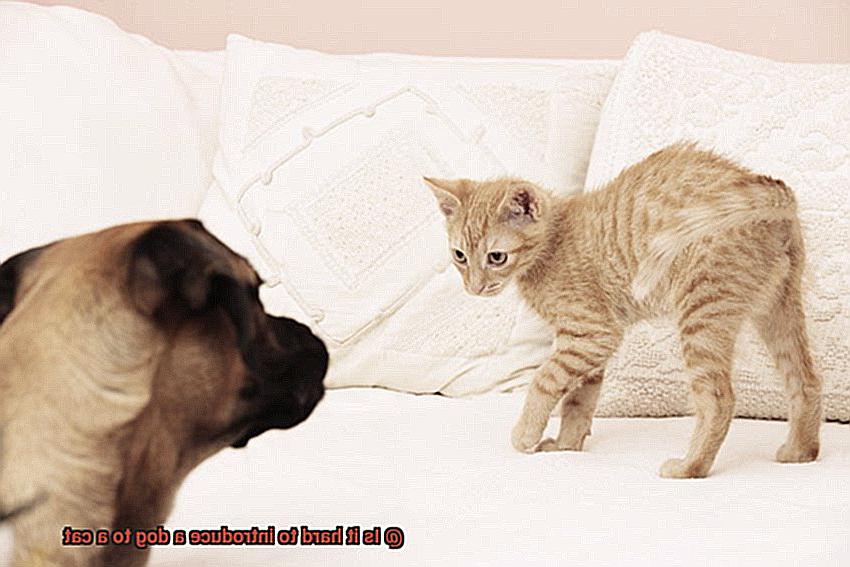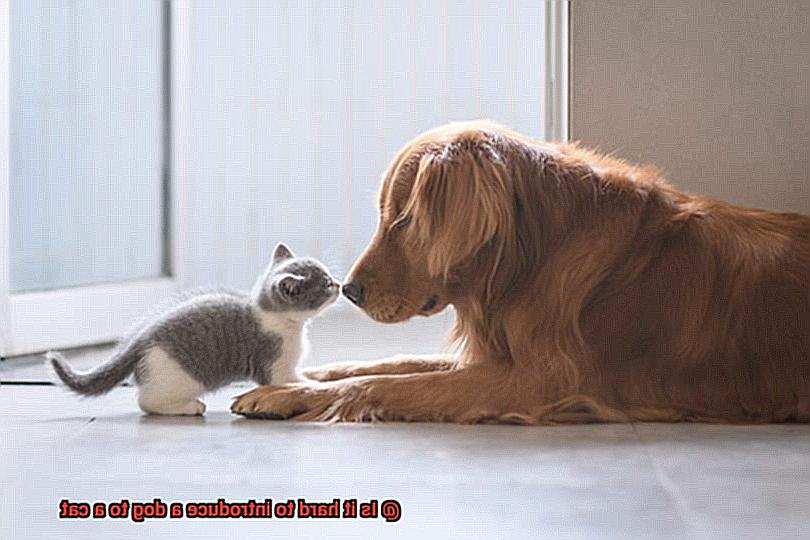Is it hard to introduce a dog to a cat?
Bringing a new furry friend into your home is thrilling, but when one has paws and a wagging tail while the other sports velvety fur and feline grace, it can get tricky. Introducing a dog to a cat requires patience, understanding, and careful management. Many pet owners embark on this adventure with butterflies in their stomachs, wondering if their fur babies will hit it off.
In this blog post, we’ll dive into the challenges of introducing dogs to cats and share tips for creating a harmonious coexistence. Whether you’re a newbie pet parent or considering expanding your fur family, understanding the dynamics between canines and felines lays the foundation for a strong friendship.
We’ll explore the natural instincts and behaviors of dogs and cats, from how they communicate to their territorial tendencies and social hierarchies. By doing so, we’ll give you insight into what to expect during the introduction phase and how to tackle potential hurdles.
Plus, we’ll arm you with practical tips and proven techniques like setting up neutral territory, using scent cues, and taking things slow. Following these guidelines will reduce stress and foster positive associations between your furry pals right from the start.
Remember, every dog and cat is unique, so success depends on various factors. Approach this process with patience, mindfulness, and knowledge for a bond that lasts.
Whether you’re an experienced pet owner or new to the game, join us as we embark on this fascinating journey of introducing dogs to cats. Together, we’ll unravel complexities, discover solutions, and unlock secrets to nurturing beautiful friendships between these magnificent creatures. Get ready to witness magic unfold as tails wag and purrs harmonize in perfect symphony.
The Impact of Personality and Temperament on Introduction
Contents
- 1 The Impact of Personality and Temperament on Introduction
- 2 Breeds with High Prey Drive and Introductions
- 3 Age and Previous Experiences Matter
- 4 Supervision During Introduction is Crucial
- 5 Scent Swapping: A Gradual Introduction Method
- 6 Positive Reinforcement Training for Appropriate Behaviors
- 7 Patience, Consistency, and Gradual Progression are Key
- 8 Conclusion
Introducing a new furry family member can be an exciting but challenging experience. When it comes to introducing a French Bulldog to a cat, understanding their personalities and temperaments is crucial for a successful introduction.
In this blog post, we will explore how personality and temperament can affect the success of introducing your French Bulldog to a cat. So grab a cup of coffee and let’s dive in.
Assessing Personality and Temperament:
Before diving into the introduction process, it’s important to assess the personalities and temperaments of both your French Bulldog and the cat. Here are some key factors to consider:
- Sociability: Is your French Bulldog naturally sociable and friendly towards other animals? Does the cat have a calm and adaptable nature?
- History of aggression: If your French Bulldog has shown aggression towards other animals in the past, extra precautions may be necessary during the introduction process.
- Stress levels: Is your cat easily stressed or anxious around new animals? Providing a safe space for them to retreat during the introduction process can be beneficial.
Approach for a Successful Introduction:
Now that you have assessed the personalities and temperaments, it’s time to plan the introduction. Here are some steps to follow:
- Gradual Introduction: Start by swapping scents between your French Bulldog and the cat. This allows them to become familiar with each other’s scent before direct interactions.
- Controlled Visual Encounters: Use baby gates or crates to create controlled visual encounters between your French Bulldog and the cat. This helps them get used to each other’s presence without direct contact.
- Positive Reinforcement Training: Use positive reinforcement techniques to reward calm and friendly behaviors from both your French Bulldog and the cat. This helps them associate each other’s presence with positive experiences.
- Supervision and Patience: Always supervise the initial interactions between your French Bulldog and the cat. Be patient and intervene if any signs of aggression or stress arise.
- Separate Resources: Provide separate sleeping areas, litter boxes, and feeding stations for your French Bulldog and the cat to prevent resource guarding or territorial disputes.
Remember, each introduction is unique, so be prepared for potential challenges and adjust your approach accordingly. With patience, consistency, and gradual progression, your French Bulldog and the cat can develop a harmonious coexistence.
Conclusion:
The impact of personality and temperament on introducing a French Bulldog to a cat cannot be overlooked. By understanding their unique traits, assessing their sociability levels, and following a gradual introduction process, you can increase the chances of a successful pawtnership.
Remember to provide separate resources and always supervise their interactions. With time and patience, your French Bulldog and the cat can become the best of friends.
Breeds with High Prey Drive and Introductions
You’ve got a French Bulldog and you’re thinking of bringing home a furry feline friend. But wait. French Bulldogs are known for their high prey drive, which can make introductions with cats a bit tricky. Don’t worry, though – I’m here to help guide you through this process. Let’s dive right in.
Slow and Steady Wins the Race

When it comes to introducing your French Bulldog to a cat, patience is key. Take things slow and don’t rush the process. Allow both animals to become familiar with each other’s scents before the initial face-to-face meeting. This can be done by swapping bedding or using pheromone diffusers in their respective areas.
Basic Training: A Must-Have
Before attempting any introductions, ensure that both your French Bulldog and cat are well-trained and responsive to basic commands. This will help establish control and create a safer environment for both animals. A well-trained dog is less likely to act on their prey drive instincts when given proper guidance.
Leash Up for Safety
During the actual introduction, it’s best to keep both your French Bulldog and cat on a leash, or in separate areas initially. This provides better control and reduces the risk of any sudden movements or interactions that may trigger your dog’s prey drive. Gradually decrease the distance between them under close supervision.
Positive Reinforcement: The Power of Treats
Positive reinforcement is a game-changer when it comes to training your French Bulldog to coexist peacefully with a cat. Reward calm behavior around the cat with treats and praise. Redirect your dog’s attention away from the cat if necessary, using toys or other engaging activities. This helps reinforce good behavior and keeps their focus on something positive.
Time and Patience: Your Secret Weapons
Successful introductions take time and patience. Remember, each dog and cat is unique, and their individual personalities will play a role in how well they can coexist. Don’t be discouraged if it takes longer than expected – building a harmonious relationship takes time.
Seek Professional Help if Needed
In some cases, it may be necessary to seek professional help from a certified animal behaviorist or trainer who has experience working with dogs with high prey drive. They can provide personalized guidance and assist you in creating a safe and positive environment for both your French Bulldog and cat.
Age and Previous Experiences Matter
Bringing a new furry friend into your home is an exciting experience, but it can also come with its challenges. When introducing a French Bulldog to a cat, age and previous experiences play a crucial role in determining how smoothly the process will go. In this article, we will explore why age and previous experiences matter and how they can affect the difficulty of introducing these two adorable creatures.
The Role of Age:
Puppies and Kittens:
- Young animals are more adaptable and open to new experiences.
- Lack of strong territorial instincts allows for curiosity and playfulness.
- Positive environment for introducing new animal companions.
Adult Dogs and Cats:
- Established behaviors and preferences may make the introduction process more challenging.
- Dogs with no prior exposure to cats may have a stronger prey drive.
- Cats with negative experiences with dogs may be fearful or defensive.
The Significance of Previous Experiences:

Dogs with Positive Experiences:
- Dogs socialized around cats from a young age or previously lived with cats tend to have positive associations with feline companionship.
- Understanding of appropriate interactions with cats may already be established.
- Enjoyment of their company facilitates a smoother integration process.

Cats with Positive Experiences:
- Cats that have lived with dogs before or have been exposed to them in a positive way are more accepting of new canine additions.
- Confidence and relaxation around dogs reduce potential conflict during the introduction process.
Individual Personalities:
Calm and Gentle Disposition:
Some dogs naturally have a calm and gentle disposition that makes them more adaptable to living with cats, regardless of age or previous experiences.
Outgoing and Social Nature:
Some cats have an outgoing and social nature, which helps them adjust more easily to the presence of dogs.
Supervision During Introduction is Crucial
You’ve decided to bring a new furry friend into your home, but there’s one catch – you already have a fabulous feline ruling the roost. Introducing a dog to a cat can be as tricky as trying to find the perfect croissant in a sea of pastries.
With a little bit of supervision and guidance, you can ensure a safe and harmonious introduction between your French Bulldog and your regal kitty.
Different Communication Styles and Instincts
Just like Parisians and New Yorkers, dogs and cats have their own unique ways of communicating. Dogs are social animals who rely on body language and vocalizations to express themselves. On the other hand, cats are more independent and use subtle cues like tail flicks and ear movements to communicate. These differences can easily lead to misunderstandings during the initial introduction, which is why close supervision is essential.
Intervention and Redirection
Supervision allows you to play the role of diplomat, stepping in when tensions rise and redirecting any negative behaviors. By keeping a watchful eye, you can prevent any harm to either pet and ensure a peaceful coexistence from the start. It’s like being a referee in a soccer match, making sure everyone plays fair and no one gets hurt.
Creating a Controlled Environment
To set the stage for success, it’s important to create a controlled environment during the introduction. You can use a baby gate or separate rooms to maintain physical separation while allowing visual and olfactory contact between your French Bulldog and your cat. This way, they can get familiar with each other’s scents and appearances without any direct physical contact.
Gauge Reactions and Behavior
By closely monitoring their interactions, you can become an expert at reading their body language. Look out for signs of fear, aggression, or discomfort from either pet. This way, you can step in and diffuse any tension before it escalates. It’s like being a mind reader, understanding their feelings even when they can’t speak your language.
Reward Positive Behaviors
Supervision also allows you to be the ultimate cheerleader for good behavior. When your French Bulldog and cat interact positively, make sure to reward them with treats, praise, and affection. Positive reinforcement goes a long way in encouraging desirable interactions and building a strong foundation for their relationship.
Gradual Increase in Interaction
Rome wasn’t built in a day, and neither is a friendship between a dog and a cat. Start with short, supervised interactions and gradually increase the duration over time. This gradual approach helps build trust and familiarity between your French Bulldog and your cat, allowing them to acclimate to each other’s presence at their own pace.
Scent Swapping: A Gradual Introduction Method
Introducing a new pet to your home can be a bit like mixing oil and water, especially when it comes to French Bulldogs and cats. However, with the right approach, you can create a recipe for success that even the most discerning taste buds would approve of.
One method that has proven to be effective is scent swapping. In this blog post, we will dive into the process of scent swapping as a gradual introduction method for French Bulldogs and cats, helping you create a harmonious household.
Why Scent Swapping?
Before we get into the nitty-gritty details, let’s understand why scent swapping is an essential step in introducing French Bulldogs and cats. Animals rely heavily on their sense of smell to navigate their surroundings and identify other animals. By exchanging scents, your furry friends can start recognizing each other’s presence, making the idea of sharing space less daunting.
The Scent Swapping Process:
- Start with a Soft Cloth or Towel: Begin by rubbing a soft cloth or towel on your French Bulldog and then place it near the cat’s living area. This allows them to become familiar with each other’s scent without direct contact.
- Exchange Bedding and Toys: Along with using a cloth, exchange bedding or toys between the two animals. This further helps in creating a positive association with each other’s scent.
- Short and Supervised Sessions: Begin with short and supervised scent swap sessions, gradually increasing the duration as both animals show positive reactions. Remember, slow and steady wins the race.
- Consistency is Key: Scent swapping should be done consistently over a period of time, allowing your French Bulldog and cat to become more familiar with each other’s presence.
- Monitor Reactions: Pay close attention to their reactions during scent swapping sessions. If either animal shows signs of stress or aggression, it may be necessary to slow down the process or seek professional guidance.

Combining Scent Swapping with Other Methods:
Scent swapping is just one piece of the puzzle when it comes to introducing your French Bulldog and cat. It should be combined with other gradual introduction methods such as visual introductions and controlled face-to-face meetings. Remember, each pet is unique, so adjusting the pace and approach to their individual needs is crucial for a successful transition.
Positive Reinforcement Training for Appropriate Behaviors
Look no further. In this blog post, we’ll explore the power of positive reinforcement training and how it can help you introduce your Frenchie to a cat, creating a paw-some bond between the two. So grab your furry friends and let’s dive into the world of positive reinforcement.
Treats, Praise, and Rewards:
Positive reinforcement training relies on rewarding desirable behaviors, such as calmly approaching the cat or ignoring aggressive tendencies. By immediately rewarding these behaviors with treats or praise, your Frenchie will associate them with positive outcomes and be more likely to repeat them in the future.
Consistency is Key:
Consistency is essential when using positive reinforcement training. Praise and reward your Frenchie every time they exhibit the desired behavior during the introduction process. This consistency helps reinforce the idea that approaching the cat calmly is a paw-sitively good thing.
Setting Clear Boundaries:
Teaching commands and cues, like “leave it,” can be paw-tastic for guiding your Frenchie’s behavior around the cat. By consistently using these commands and rewarding compliance, your Frenchie will learn to respect boundaries and understand what behaviors are expected of them.
Patience is a Virtue:
Remember, introducing a Frenchie to a cat requires patience and gradual progress. Rushing the process can lead to stress and potential conflicts between the animals. Start with short supervised interactions and gradually increase their duration as both animals become more comfortable.
Close Monitoring:
Keeping a close eye on their behavior during the introduction process is crucial. If you notice any signs of aggression or stress, intervene immediately. Safety should always be a top priority for your furry friends.
Patience, Consistency, and Gradual Progression are Key
Introducing a French Bulldog to a cat can be a rewarding experience, but it requires patience, consistency, and gradual progression. Every dog and cat is unique, and their reactions to each other may vary. By following these steps, you can ensure a smooth and successful introduction.
Step 1: Start with Separate Spaces
- Keep the dog and cat in separate spaces initially.
- Allow them to sniff and investigate each other’s scents without direct interaction.
- Swap their bedding or use a barrier like a baby gate or screen door.
Step 2: Observe Body Language
- Watch for signs of stress or aggression in both animals.
- If either animal shows fear or aggression, give them more time apart.
- Consider seeking advice from a veterinarian or animal behaviorist.
Step 3: Supervised Face-to-Face Introductions
- Use leashes on both the dog and cat during initial face-to-face introductions.
- Remain calm and provide positive reinforcement through treats and praise when both animals display calm behavior.
Step 4: Gradually Increase Interaction
- As the introductions progress positively, allow short periods of supervised interaction without leashes.
- Monitor their behavior closely during these sessions.
- Separate them immediately if any signs of aggression or tension arise.
Step 5: Consistency is Key
- Establish a routine that includes regular supervised interactions, positive reinforcement, and maintaining separate spaces when unsupervised.
- This consistency will help both the dog and cat understand their boundaries and expectations.
3lcEU3Gfyhk” >
Conclusion
Introducing a dog to a cat can be quite challenging, but with the right approach and patience, it is definitely possible to create a harmonious environment for both furry friends. It’s important to remember that each animal has its own unique personality and preferences, so there are no guarantees of an instant bond. However, by following some key steps and guidelines, you can increase the chances of a successful introduction.
Firstly, it’s crucial to start with separate living spaces for your new dog and cat. This allows them to become familiar with each other’s scents without feeling threatened or overwhelmed. Gradually introduce their scents by swapping bedding or using pheromone sprays to create a sense of familiarity.
Next, controlled visual introductions can help gauge their initial reactions. Keep them in separate rooms but allow them to see each other through a baby gate or cracked door. This way, they can observe one another while still maintaining a safe distance.
When it comes time for face-to-face interactions, always prioritize safety. Use leashes or harnesses on both animals during these initial meetings. This provides control and prevents any potential altercations.
Positive reinforcement plays a vital role in the process of introducing a dog to a cat. Reward good behavior from both parties with treats and praise. This helps them associate positive experiences with each other’s presence.
Remember that patience is key throughout this process. It may take days or even weeks before your dog and cat feel comfortable around each other. Be prepared for setbacks along the way but remain consistent in your efforts.
In conclusion, introducing a dog to a cat may require some effort and time, but it is not an impossible task. By taking things slowly, prioritizing safety, and using positive reinforcement techniques, you can increase the likelihood of fostering a peaceful coexistence between your furry companions.




